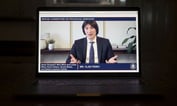 (Photo: AP)
(Photo: AP)
The Federal Reserve took action to calm money markets, injecting billions in cash to quell a surge in short-term rates that was pushing up its policy benchmark rate and threatening to drive up borrowing costs for companies and consumers. The central bank also said it would do more Wednesday.
While the spike wasn’t evidence of any sort of imminent financial crisis, it highlighted how the Fed was losing control over short-term lending, one of its key tools for implementing monetary policy. It also indicated Wall Street is struggling to absorb record sales of Treasury debt to fund a swelling U.S. budget deficit. What’s more, many dealers have curtailed trading because of safeguards implemented after the 2008 crisis, making these markets more prone to volatility.
Money markets saw funding shortages Monday and Tuesday, driving the rate on one-day loans backed by Treasury bonds — known as repurchase agreements, or repos — as high as 10%, about four times greater than last week’s levels, according to ICAP data.
More importantly, the turmoil in the repo market caused a key benchmark for policy makers — known as the effective fed funds rate — to jump to 2.25%, an increase that, if left unchecked,
But the central bank didn’t wait until then to do something, resorting to a money-market operation it hasn’t deployed in a decade. The New York Fed bought $53.2 billion of securities on Tuesday, hoping to quell the liquidity squeeze. It appeared to help. For instance, the cost to borrow dollars for one week while lending euros retreated after almost doubling Monday.
Late Tuesday, the New York Fed said it would conduct another overnight repo operation of up to $75 billion Wednesday morning.
For repo traders, hedge funds and others that rely on that market for financing, the intervention came none too soon.
“There’s been a sea change in markets, and it’s one the Fed needed to respond to,” said Lou Crandall of Wrightson ICAP. “In the current market environment, there is just not enough elasticity in the repo market to handle the big seasonal swings of the banking system. The Fed needed to come in now and alleviate the immediate problem, while it is also working on long-term solutions.”
The central bank has considered introducing a new tool, an overnight repo facility, that could be used to reduce pressure in money markets. No decision has been announced. Another long-term remedy would be growing the Fed’s balance sheet again to permanently increase reserves in the banking system. But for now, if the rate remains elevated, expect more temporary liquidity injections, Crandall said.








 September 17, 2019 at 05:45 PM
September 17, 2019 at 05:45 PM












 Copyright © 2024 ALM Global, LLC. All Rights Reserved.
Copyright © 2024 ALM Global, LLC. All Rights Reserved.